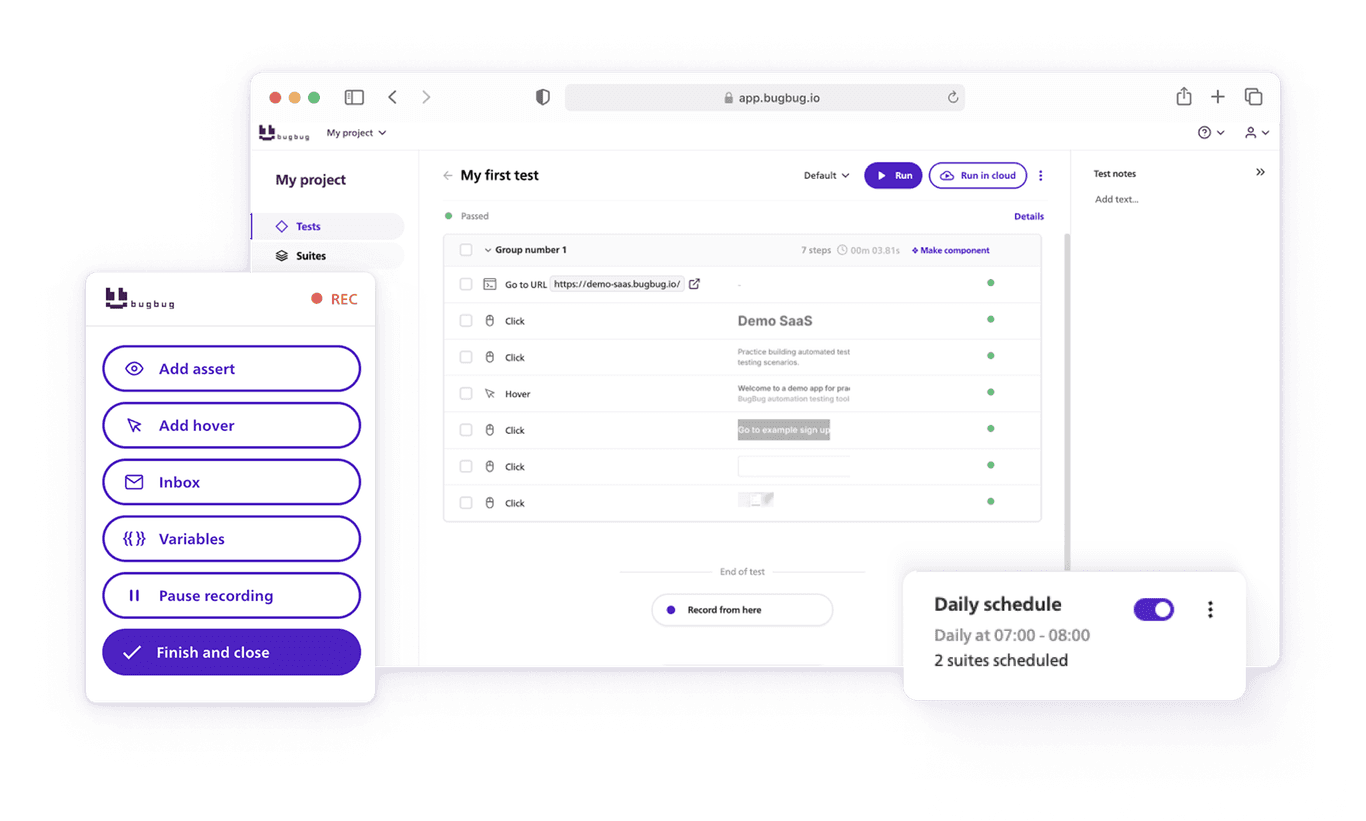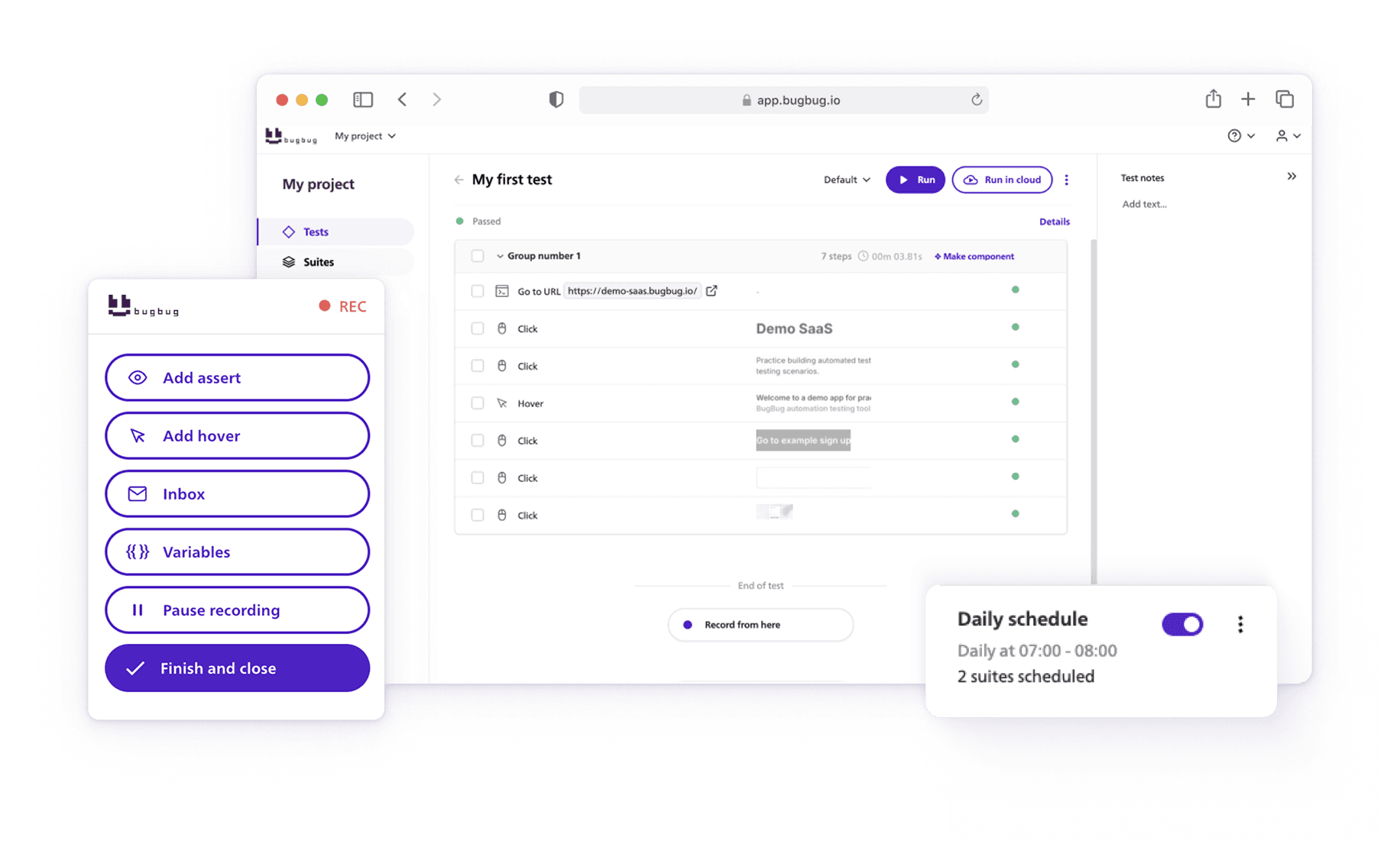🤖 Summarize this article with AI:
💬 ChatGPT 🔍 Perplexity 💥 Claude 🐦 Grok 🔮 Google AI Mode
There was a time when QA meant clicking through test cases by hand and hoping nothing broke. Today, those days are gone. Modern software teams—especially those shipping weekly or daily—have embraced automation not as a luxury, but as a baseline requirement.
- 🎯 TL;DR - Best Automation Testing Tools
- Introduction to Automated Testing
- Benefits of Automation
- Types of Testing You Can Automate
- Best Automation Tools and Frameworks
- CI/CD Pipelines and Integration
- Best Practices for Test Automation
- Open-Source Automated Testing Tool
- Future of Automation Testing
- Conclusion
- FAQ: Modern Automation Testing Tools (Codeless + Code)
🎯 TL;DR - Best Automation Testing Tools
- Automation testing is essential for speed, accuracy, and scalability in modern software delivery.
- Common types: unit, integration, functional, end-to-end, load/performance, cross-browser, API.
- Tool options:
- Codeless: BugBug, Testim, Katalon, Ranorex
- Code-heavy: Selenium, Playwright, Cypress, Appium, JUnit, Karate DSL
- Performance: Postman, JMeter, k6, Gatling
Check also:
Introduction to Automated Testing
Automated testing, or test automation, refers to the use of software tools to execute predefined test cases. This technique allows teams to validate application behavior, spot regressions early, and push code with confidence. Whether you’re running unit tests in your CI pipeline or executing end-to-end flows across browsers, automation is your safety net.
A solid automation tool doesn’t just run tests—it supports collaboration, scales with complexity, and integrates seamlessly into your delivery pipeline. More importantly, it should improve your team’s speed without sacrificing quality.
Automate your tests for free
Test easier than ever with BugBug test recorder. Faster than coding. Free forever.
Get started
Benefits of Automation
Why automate? Because manual testing, while valuable, can’t keep up with today’s release cycles.
Automation:
- Increases efficiency by handling repetitive and time-consuming tasks
- Reduces costs over time through reusable scripts and stable pipelines
- Improves accuracy by eliminating human error in repetitive scenarios
- Enables continuous testing and early bug detection
- Frees up QA specialists to focus on edge cases, exploratory testing, and UX
It’s not just about running tests faster—it’s about building a foundation where quality becomes scalable.
Types of Testing You Can Automate
Software testing isn’t a monolith. There are many flavors:
- Unit testing: verifying individual components or functions
- Integration testing: ensuring different parts of the system interact correctly
- Functional testing: validating features against requirements
- End-to-end testing: testing full user workflows across systems
- Load & performance testing: measuring system behavior under stress
- Cross-browser testing: ensuring UI works across environments
- API testing: validating backend logic and data contracts
Most modern frameworks can support multiple types of testing. The key is to match the right tool to your context.
Best Automation Tools and Frameworks
Choosing a test automation tool isn’t just about features—it’s about fit. You want a tool that aligns with your tech stack, your team’s coding skills, and your deployment speed.
Some key factors to consider:
- Ease of test creation (code vs codeless)
- Browser and device coverage
- Programming language support
- CI/CD integration
- Test data and environment management
Here’s our curated list of the best automation testing tools used by QA engineers, product managers, and developers alike—to scale their quality practices.
Codeless & No-Code Tools
Perfect for agile teams, startups, and non-technical testers.
- BugBug A lightweight, codeless testing tool built for web apps. With visual test creation, step-by-step execution, and a generous free plan, BugBug is ideal for teams who want flexibility without the coding overhead. Its Chrome-based architecture makes it fast, while its "Edit & Rewind" feature makes debugging smooth. Great for startups.
- Testim An AI-powered platform for web UI testing with self-healing capabilities. Particularly useful for large teams managing hundreds of test cases that frequently break due to UI changes.
- Katalon Studio A hybrid solution combining low-code convenience with full-code extensibility. Built on top of Selenium and Appium, it's ideal for cross-platform projects.
- Ranorex Great for Windows desktop and web testing. Offers a powerful record/playback engine with .NET integrations. Codeless to start, with scripting available when needed.
Choose user-friendly, codeless tool
Test easier than ever with BugBug test recorder. Faster than coding. Free forever.
Get started
Developer-Friendly Frameworks
Powerful options for teams with development capacity.
- Selenium: The OG of test automation. Open-source, battle-tested, and infinitely flexible. Best for teams who need full control and can manage test infrastructure.
- Playwright: Microsoft-backed and modern. Offers auto-waiting, built-in tracing, and multi-browser support out of the box. Great for fast, reliable UI testing.
- Cypress: Loved by frontend developers. Runs directly in the browser, offers blazing speed and time-travel debugging. Limited to Chromium-based browsers but powerful within its domain.
- Appium: The go-to framework for mobile app automation. Supports both Android and iOS using a single test codebase. Integrates well with Selenium-based setups.
- JUnit: A foundational Java unit testing framework. It may seem old-school, but it's crucial for teams practicing test-driven development (TDD) or continuous integration.
- Karate DSL: A BDD-style API testing tool that supports data-driven tests, JSON validation, and parallel execution. Especially useful for backend-focused teams.
Bonus: Load & Performance Tools
Load and performance testing is often where traditional QA efforts fall short. These specialized tools support testing under extreme conditions, offering insights into how your app behaves when it matters most. Whether you're running stress tests, analyzing performance bottlenecks, or validating throughput during peak hours—these tools help you scale with confidence.
- Postman – While often associated with functional API testing, Postman also supports automated test scripts, mocks, and monitors. It plays a key role in regression testing for APIs and is invaluable in early-stage development processes.
- Apache JMeter – The veteran of load testing tools. Ideal for testing application performance and stability under different loads. It supports testing both static and dynamic resources and allows integration into CI/CD workflows for fast test execution and regression validation.
- k6 – A developer-centric load testing tool written in JavaScript. Built for modern web applications and microservices, k6 enables testing with minimal coding expertise. It's perfect for CI environments and supports testing as part of the broader test automation framework.
- Gatling – Built with Scala, Gatling shines in expressive performance scenarios and data-driven testing. It’s designed for engineering-heavy teams that value reliability and comprehensive testing coverage during the development lifecycle.
These tools complement your broader test automation process by enabling testing at scale, providing detailed test reports that feed directly into your test management system, and ensuring your team can create automated tests that simulate real-world traffic patterns.
CI/CD Pipelines and Integration
Automation doesn't exist in a vacuum. Integrating your test suite with CI/CD pipelines like Jenkins, GitLab CI, or CircleCI ensures your tests run automatically with every push. Parallel execution helps you test faster. Smart test orchestration reduces flakiness.
CI/CD tools support testing across a wide range of automation frameworks—whether you're using codeless test automation tools like BugBug or code-heavy solutions like Selenium. Unified test automation platforms often include native integrations that enable testing to become a natural part of your deployment pipeline.
From regression testing and mobile testing to desktop testing and user acceptance testing, continuous integration ensures consistency and speed without compromising test coverage. Proper integration also enhances test execution and enables faster feedback cycles—essential for agile development processes.
Best Practices for Test Automation
- Start small. Don’t aim to automate 100%—focus on high-value scenarios first.
- Prioritize high-risk, high-impact test cases across your application.
- Use tags and modular test structures to manage test suites effectively.
- Keep tests independent to reduce test maintenance and test failures.
- Review detailed test reports regularly to assess trends and blind spots.
- Reuse common flows and avoid duplicating the same test logic.
- Optimize for flaky test detection using test automation frameworks that support retry logic and root cause analysis.
Open-Source Automated Testing Tool
Open-source doesn’t mean inferior—it means flexible, customizable, and battle-tested. Tools like Selenium, Appium, TestNG, and Robot Framework have powered test automation for some of the largest engineering organizations in the world. They provide comprehensive support for everything from desktop testing and mobile testing to regression testing, acceptance testing, and even user acceptance testing.
What you gain in control and extensibility, however, you may lose in ease of setup and ongoing test maintenance. Open-source tools often require more coding expertise, robust test automation frameworks, and integration effort to match the velocity of modern development teams.
They’re not ideal for non-technical users or teams that need to quickly create automated tests across multiple devices or browsers. Still, if your testing process is mature and your development lifecycle depends on deep customization or parallel testing, open-source may be your best bet.
Future of Automation Testing
The trend is clear: more abstraction, more AI, and more collaboration.
AI-based tools like Testim are already self-healing broken tests. Unified test platforms are emerging—blending static analysis, visual validation, API testing, and UI automation. And tools like BugBug are simplifying test creation to the point where even product managers can write tests.
Expect to see rapid innovation in:
- Smart test orchestration (e.g., prioritizing based on code changes or user journeys)
- Test intelligence and flake detection
- Fast test execution pipelines with zero-config parallelism
- Broader support for mobile testing, API regression testing, and stress tests
- Data-driven testing becoming the norm for complex decision trees
- Seamless integration with CI/CD pipelines across all environments
If testing used to be a quality gate, it's now becoming a shared, continuous effort woven through every layer of the development lifecycle.
Conclusion
Modern software teams rely on a blend of functional testing and end-to-end testing to achieve the kind of comprehensive testing coverage required in today’s fast-paced environments. As automated testing frameworks evolve, they reduce the burden of repetitive testing tasks and enable QA specialists to shift their testing efforts toward more strategic areas like usability testing and exploratory QA.
These frameworks not only streamline test execution but also allow teams to scale their test automation process without compromising quality. By integrating automated workflows that handle everything from unit assertions to UI flows, organizations can maintain reliability, accelerate feedback loops, and deliver software that’s truly user-ready.
The right tool can make or break your QA strategy. Whether you’re building a startup MVP or scaling an enterprise SaaS product, there’s a testing framework that fits your workflow.
Start with what’s manageable. Evolve as your needs grow. And above all—don’t chase trends. Chase reliability.
BugBug was built for teams that care about speed and quality. If that’s you, we should talk.
Happy (automated) testing!



